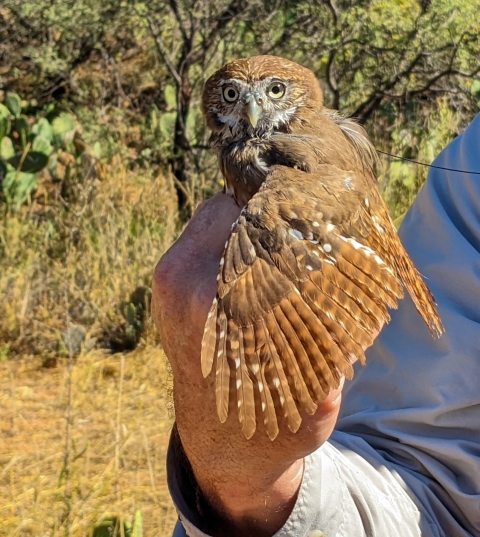PHOENIX–Following a 60-day public comment period, the U.S. Fish and Wildlife Service is listing the cactus ferruginous pygmy-owl as a threatened subspecies under the Endangered Species Act, along with a 4(d) rule that tailors protections for the owl. Service biologists will propose designating critical habitat for the species in a separate rule at a later date.
In response to comments made by stakeholders, partners, and the public, Service biologists made additions to this final rule to further explain new information received between the previous not-warranted finding in 2011 and the 2021 proposed listing, as well as incorporated data and information provided during the public comment period, as appropriate.
The pygmy-owl is a 6-inch-tall raptor currently found in southern Arizona, southern Texas, and Mexico. The owl is imperiled throughout its range by activities that reduce and fragment its habitat. These threats include but are not limited to, invasive species invasive species
An invasive species is any plant or animal that has spread or been introduced into a new area where they are, or could, cause harm to the environment, economy, or human, animal, or plant health. Their unwelcome presence can destroy ecosystems and cost millions of dollars.
Learn more about invasive species , urbanization, agriculture and forest production, and climate change climate change
Climate change includes both global warming driven by human-induced emissions of greenhouse gases and the resulting large-scale shifts in weather patterns. Though there have been previous periods of climatic change, since the mid-20th century humans have had an unprecedented impact on Earth's climate system and caused change on a global scale.
Learn more about climate change . It has been extirpated from key areas of its historical range in both Arizona and Texas. Notable declines are also reported in the Mexican portion of the pygmy-owl’s range, especially in Northern Sonora, Mexico.
“The Endangered Species Act provides a critical safety net for fish, wildlife and plants and has prevented the extinction of hundreds of imperiled species like the pygmy-owl,” said Southwest Regional Director Amy Lueders. “In addition, collaborative conservation efforts with a diversity of cooperators in Arizona, Texas and Mexico have further protected pygmy-owl habitat through habitat acquisition and protection in Arizona and have greatly enhanced our understanding of the species.”
Pygmy-owl habitat has been protected through conservation planning and habitat acquisition and protection as part of implementing the Pima County Multi-Species Conservation Plan. Participation in the plan is voluntary and provides non-federal landowners and industry the opportunity to implement proactive conservation practices that address specific threats to imperiled species. In turn, the landowner receives assurances that if the species eventually becomes listed under the Endangered Species Act, they can continue to manage their land as outlined in their agreements with no additional requirements. In addition, the Altar Valley Watershed Plan has been developed and will contribute to the enhancement of pygmy-owl habitat in Altar Valley, Arizona. Other collaborative efforts with a diversity of cooperators have enhanced our knowledge of pygmy-owl needs through ongoing cooperative surveys, research, and monitoring in Arizona, Texas, and Mexico.
The Service developed a species status assessment (SSA) using the best available science and available information from a team of local, state, federal, and Tribal experts, as well as conservation partners, concerning the past, present, and future threats, as well as ongoing conservation efforts. Based on the analysis in the SSA regarding the projected future condition of the species, the cactus ferruginous pygmy-owl is likely to become an endangered species in the foreseeable future primarily due to habitat loss and fragmentation, and climate change.
The 4(d) rule prohibits the same activities as outlined in the Endangered Species Act for an endangered species but allows certain exceptions. These exceptions include specific types of education and outreach activities already allowed under a Migratory Bird Treaty Act permit, surveying and monitoring conducted in Arizona under a state-issued Scientific Collection License, and habitat restoration and enhancement activities that improve habitat conditions and which are coordinated with and approved by the Service.
This announcement comes as the ESA turns 50 years old in 2023. Throughout the year, the Department of the Interior is celebrating the ESA’s importance in preventing imperiled species extinction, promoting the recovery of wildlife and conserving the habitats upon which they depend.
The full listing rule will be available at www.regulations.gov by searching under docket number FWS-R2-ES-2021-0098. This listing rule goes into effect 30 days after publication. The service remains interested in information regarding the status and conservation of, and any potential threat to, the cactus ferruginous pygmy-owl. Please submit information by email to incomingazcorr@fws.gov.
Frequently Asked Questions
Final Listing, Cactus Ferruginous Pygmy Owl
Q: Are there different threats for different populations in U.S. and Mexico?
A: The main threats to the pygmy-owl’s survival are the same in both the U.S. and Mexico. The primary impacts are climate change, conditions, and habitat fragmentation and loss. However, each analysis unit is unique ecologically, geographically, or politically. The threats contributing to or resulting from these two primary factors do not occur consistently across all analysis units, but all analysis units are being impacted by one or more of the threats discussed in this final rule and the Species Status Assessment report.
The Arizona analysis unit currently has the lowest pygmy-owl abundance of all analysis units, with a population estimated to be in the low hundreds. Habitat fragmentation and loss from urbanization and increases in invasive species such as buffelgrass have reduced the availability and connectivity of habitat in this analysis unit. Additionally, climate conditions have reduced prey availability and vegetative cover through increased temperatures and drought. These factors result in a reduced capacity for this analysis unit to withstand unpredictable ecological events and result in low resiliency.
The northern Sonora analysis unit has an estimated pygmy-owl abundance in the high hundreds. However, this analysis unit is affected by habitat fragmentation from urbanization, agricultural development, and associated infrastructure. These stressors increase human water use affecting riparian riparian
Definition of riparian habitat or riparian areas.
Learn more about riparian vegetation communities and, in conjunction with climate conditions, reduce the quality and availability of pygmy-owl habitat. Due to moderate owl abundance and some decrease in habitat availability and connectivity, the northern Sonora analysis unit has a moderate level of population resiliency.
The western Mexico analysis unit is estimated to have tens of thousands of pygmy-owls. This analysis unit has some habitat fragmentation from urbanization, agricultural development, and deforestation of the tropical deciduous forests. Overall, the western Mexico analysis unit has high population resiliency due to a high abundance of pygmy-owls and generally healthy vegetation cover, likely as a result of higher levels of precipitation in the region.
The Texas analysis unit has an estimated pygmy-owl abundance in the high hundreds. Land uses within this analysis unit have resulted in habitat fragmentation and, due to agricultural development and wood harvesting within the Rio Grande Valley, this analysis unit is somewhat genetically isolated from the rest of the geographic range of the subspecies. Due to moderate pygmy-owl abundance, fragmentation of habitat, and some genetic isolation, the Texas analysis unit has a moderate level of population resiliency.
The northeast Mexico analysis unit is estimated to have tens of thousands of pygmy-owls. However, this unit has high levels of habitat fragmentation due to urbanization and agricultural development. Overall, the northeast Mexico analysis unit has a moderate level of population resiliency with some capacity to withstand stochastic events.


